Germaine Monteil
Continue onto: Germaine Monteil (post 1945)
Germaine Monteil (pronounced “Montay”) was born Marie Germaine Moratille at 57 Rue Galande, Paris in 1898. Her father, Jean Moratille [b.1872], a postal worker, and mother, Amélie Bricaud [b.1879], had married the previous year. In 1901, she gained a brother, Gabrielle Lucienne Moratille, but lost her mother prematurely in 1903.

Above: Rue Galande, Paris photographed by Eugène Atget [1857-1927] in the early 1900s. The arch up the road on the right marks the approximate position of 57 Rue Galande.
Germaine moved to New York in 1919 and her brother did the same in 1923. There she met Guy Bjorkman, an interior decorator, marrying him in 1924. Guy was also born in France but had emigrated to the United States in 1915. Both became naturalised Americans; Guy in 1921, Germaine in 1926.
Dress designer
Germaine listed her occupation as designer on her naturalisation petition. Dress historians suggest that after arriving in America she worked for the high-end clothing manufacturer Anthony Traina [1887-1966] and the New York designer Harry Collins [1884-1980] before starting her own business, Germaine Monteil, Inc., at 36 West 47th Street, New York, in 1929. When naming the company she adopted the maiden name of her grandmother on her mother’s side of the family – Marie Monteil – who appears to have been living with the Moratille family when Germaine’s mother died.

Above: Finishers assembling garments that require hand work in the Germaine Monteil factory (Fortune, June, 1930).
How and why Germaine got involved in fashion is unknown to me. However, her brother Gabrielle listed his occupation as milliner on his naturalisation application so clothing may have been a family interest.
For completeness, I note that there is at least one reference to Germaine Monteil having been a dancer, an idea that may be supported by a photograph of a Germaine Monteil in the Billy Rose Theatre Collection (New York Public Library).
Her clothes suit the busy life of the modern woman. They are built from the midriff—a trick Mme. Monteil has taken from her experience as a dancer and a sure sign of her basic knowledge of anatomy.
(Germaine Monteil advertorial, 1940)
Cosmetics
In December, 1935, Germaine Monteil introduced a cosmetic range with a fashion show and cocktail party in her New York salon. The line was wide ranging, covering both skin-care and make-up. The following year the Germaine Monteil Cosmetiques Corporation was established to handle the cosmetics side of her business managed by Guy Bjorkman.

Above: 1936 Germaine Monteil introductory set.
A number of writers have suggested that Germaine got interested in cosmetics by making lipsticks to match her outfits. This certainly happened after 1935 but I think it followed the creation of her cosmetic line rather than being something she did beforehand – lipsticks are not easy to make. Monteil would later claim that the source of the range was French but I find this origin story hard to believe.
Some years ago I reached Paris completely exhausted. Months of designing had left me no time to take care of my skin. … I met a friend whom I had not seen for two years and she could scarcely conceal her concern over my changed appearance …
She brought me to a quiet salon not twenty feet from the roaring traffic off the Rue de la Paix—the salon of a specialist who has literally held back the years from the leaders of European society.
… Each time I left her salon a new woman. I left a wiser and happier woman too, for I had seen miracles performed in the midst of twentieth century Paris. …
I bought her preparations home with me. … I used them faithfully, urged my friends to use them. The results were all that I had promised. My friends begged for more.
Then I made my decision. I purchased the precious formulas. They are now compounded in my New York laboratory by a chemist of international repute. Flaconed in containers of my own designing, and bearing my name, they are now available to the select clientele of the exclusive shops which show my original gown models.(‘Germaine Monteil Cosmetiques,’ c.1937, pp. 4-6)
See also: Germaine Monteil Cosmetiques (c.1937)
It was a bold move to introduce a new cosmetics range in the middle of the Great Depression but the line had name recognition and was aimed at the upper end of the market with prices to match. Sold through stores such as Saks Fifth Avenue, Bonwit Teller’s and Altman’s the cosmetics were bought by women who were less likely to have been affected by the economic difficulties of the time.
The cosmetics were packaged in elegant ivory containers labeled with Germaine Monteil in small case letters and the product in small caps. Advertising and promotion was done through Gussow-Khan & Company, New York.
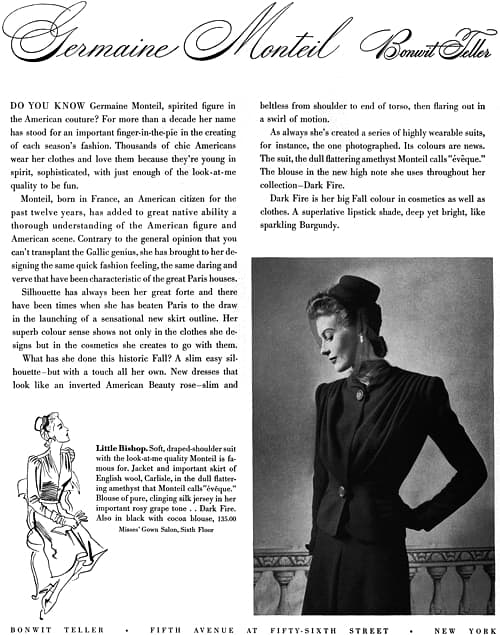
Above: 1940 Germain Monteil fashions and cosmetics sold through Bonwit Teller.
The initial product range consisted of a “cleansing cream, cleansing tonic, stimulating cream for morning use, night feeding cream, astringent, beauty balm as a light emollient and powder base, face powder in seven shades, lipstick in five shades, cream rouge and powder rouge in five shades, eye shadow in five shades, complexion soap and bath powder with deodorizing properties” (AP&EOR, 1935).
Skin-care
The basic Germaine Monteil skin-care routine followed a standard three-step – cleansing, toning, skin cream – pattern. Women could cleanse with Cleansing Cream if their skin was normal or Non-Liquefying Cleansing Cream if their skin was dry. Residual cleanser was removed with Cleansing Tonic before Beauty Balm was applied as a powder base and day-time skin proectant. At night women had a choice between Night Feeding Cream for dry skins or Nourishing Cream for normal skin types.
With a spatula spread germaine monteil Cleansing Cream on a generous sized pad of absorbent cotton that has been squeezed out of water. Cleanse the throat and face gently with this pad in form upward and outward strokes but do not push or pu;l the skin. repeat until the skin is thoroughly cleansed. Remove the cream with cleansing tissues.
Now pour germaine monteil Cleansing Tonic on afresh cotton pad and gently wipe the entire face and throat to remove the last traces of cream and to contract the pores to firmness. Pat briskly with the pad and your face will feel smooth glowing and alive.
Blot the skin dry with cleansing tissue.‘Germaine Monteil Cosmetiques,’ 1937, p. 7)
Cleansing Cream: “Every trace of impurity, make-up and grime is flushed away, leaving your skin glowing with health and cleanliness.”
Cleansing Tonic: “Its purpose is two-fold: to remove the last trace of film of Cleansing Cream . . . and to close each pore.”
Night Feeding Cream: “The gentle, triple action of this three-fold beauty treatment works as you sleep. It penetrates deep into every tiny pore. It nourishes the skin back to the suppleness of youth. It refines roughened textures to satin smoothness.”
Astringent: “Its tonic qualities not only strengthen flabby tissues but also stimulate an increased blood circulation . . . thereby assisting Nature to rebuild from within.”
Beauty Balm: “This delicate, creamy liquid re-supplies the precious, natural moisture that is robbed from our skins by conditions of modern life. It is healing . . . soothing . . . yet one is never conscious of a powder base on the skin.”
Early additions to the skin-care range included products for troubled skins, face masks, and a skin bleach.
Plastic Cream/Plastic Mask: “Excellent for listing and firming sagging muscles and for erasing fatigue lines.”
Pore Cream: “Enlarged pores are the result of improper cleansing. Unless the pores are cleansed to their depths, they become chocked grow larger and often lead to blackheads … Pore Cream meets this condition.”
Acne Cream: “This mild, medicated cream quickly and gently relieves simple acne and skin eruptions.”
Acne Lotion: “A product compounded for sufferers of simple acne, who do not wish to use too many creams. The clearing process may be hastened by adding a few drops of Acne lotion to Beauty Balm, and applying same before your powder.”
Bleach Cream: “It is excellent for a sluggish complexion and for quickly removing any traces of tan.”
Sun-care
By 1937, Germaine Monteil had added three preparations specifically for the beach or outdoor sports with the Sun Cream packaged in a convenient tube that could be taken to the beach.
Sun Cream: “[T]o prevent a sensitive skin from burning.”
Suntan Oil: “[T]o turn you a toasty-tan.”
Sunproof Lotion: “[T]o prevent burning and freckling. Blended with Beauty Balm for your make-up base.”
The addition of Bronze Beauty Balm (1940), a new shade of Beauty Balm, also allowed women to tan without suntanning.
Bronze Beauty Balm: “[T]o allow you to wear a tan before you’ve earned a tan.”
In the 1940s, some Germaine Monteil products had to be renamed after the passing of the Food, Drug and Cosmetic Act (FD&CA) of 1938 identified them as misbranded. Night Feeding Cream looks to have been renamed/reformulated as Night Skin Cream, Nourishing Cream as Rose Skin Cream, Cleansing Tonic as Skin Freshener, and Sunproof Lotion as Sun-Pruf Lotion.
Make-up
As previously noted, the initial Germaine Monteil make-up range consisted of face powder, lipstick, rouge and eye shadow with names chosen to resemble those used to describe fabric colours.
Germaine Monteil Beauty Balm was recommended as a powder base. Initially only available as a colourless cream, the original balm was referred to as Transparent after the Bronze (1940) and Muted Rose (1941) shades were added.
Germaine Monteil suggested that two shades of powder be used when powdering the face to give greater depth of tone, starting with a darker shade and then overlaying it with a dusting of a lighter powder. This appears to be a copy of the Elizabeth Arden’s Two Powder Technique, introduced in 1935.
See also: Elizabeth Arden (1930-1945)
Face Powder: “Will cling to your skin like a gossamer veil . . . lending enchantment while giving protection.” Shades: Peach, Flesh, Naturelle, Rachel, Light Ocre, Antibes, and Sunburn. Later shades included Champagne Diamond (1939), and Muted Rose (1941).
Lipstick: “Of a rich, creamy texture . . . colored solely by vegetable coloring matter . . . it protects the lips against chapping while covering them with a dewy film of exquisite and lasting color.” Shades: Chinese, Flame, Geranium, Cardinal, and Renaissance with Burma Ruby added in 1939.
Cream Rouge: “[D]elicate in consistency, easy to apply.” Shades: Chinese, Flame, Geranium, Cardinal, and Renaissance with Burma Ruby added in 1939.
Powder Rouge: “Delicate in texture and in coloring … gives the cheek a natural flush. for evening . . . super-imposed on powder over cream rouge . . . it gives a particularly flattering effect.” Shades: Chinese, Flame, Geranium, Cardinal, Renaissance, and Ash Rose with Burma Ruby added in 1939.
Eye Shadow: “[W]ill lend a depth and brilliance to the eyes.” Shades: Flag Blue, Light Blue, Purple, Brown, and Green.
By 1937, Germaine Monteil had expanded its make-up range to include a cake/block mascara and an eyebrow pencil.
Mascara: “[G]ives a natural, silky effect and is absolutely harmless.” Shades: Black, Brown, Green, and Blue.
Eyebrow Pencil: “[A]pproximates the natural brow pigment and is of a perfect consistency.” Shades: Black, and Brown.
In 1938, Germaine Monteil introduced a larger Jumbo lipstick recognised by its ribbed inner container. It was refillable which came in handy during the metal lipstick shortage in the Second World War. The following year the new lipstick was matched with a Lip Vue night and day mirror.

Above: 1939 Germain Monteil Lip Vue Mirror and Jumbo Lipstick that fitted inside the handle.
The original and Jumbo lipsticks came in the same shades with nadded shades such as Pink Ice, Dark Fire, Singing Red, Smoulder Red, and Red Africa (1940); and Theatre Red (1941) also matched in cream and powder rouges. Shades I have been unable to date mentioned this period included Azalea, and Hot Pink, both on sale by 1940.
In 1938, Germaine Monteil introduced a pack of three, small lipsticks resting on an ivory-coloured satin cushion encased in a clear plastic container sealed with an ivory-coloured satin ribbon. This potential gift item was referred to as a ‘lipstick wardrobe’ which, as far as I can tell, was the first time someone named a set of lipsticks this way. They continued to be sold after the war with a Superglow version added in the 1950s.
The Germaine Monteil lipstick wardrobes were grouped by hair colour, a determining factor often used when selecting appropriate shades of clothing. For example, a Lipstick Wardrobe for brunettes contained Pink Ice, Dark Fire, and Geranium, while the one for designed for blondes included Azalea, Burma Ruby, and Renaissance.
Applying make-up
The Germaine Monteil make-up routine was a little unusual. After applying Beauty Balm, Germaine Monteil’s best selling line, as a powder base, she recommended applying lipstick before applying rouge and powder.
Dampen the face and neck thoroughly with Beauty Balm and allow it to dry. This will take about two minutes. While the Beauty Balm is drying apply your lipstick. This, undoubtedly, will sound revolutionary to you if you have been accustomed to applying lipstick as the last step in make-up, but try it, please. It is the expert touch. You will follow the natural outline of the mouth . . . a line that can be obscured if you powder first. Outline the upper lip only then press the lips together. The upper lip will imprint the lower. With your finger blend the lipstick into the skin. Blot surplus with cleansing tissue.
The tiniest bit of eye-shadow on your finger tip applied on the upper lid as near the lashes as possible and blended upward and outward will make your eyes appear brighter and larger.
In applying rouge . . . and cream rouge is best . . . do it sparingly and carefully. Press your finger lightly to the cream rouge and apply in four dots high on the cheek bone beginning under the center of the eye and continuing to a point under the eye’s outer corner. With your finger tips blend the rouge upward and outward . . . and continue blending until there is not the slightest hint of a sharp, artificial outline.
Now you are ready for powder. This is the expert method of applying it so that your skin will have a smooth, velvety appearance with no hint of powder showing. First, powder the face and neck lavishly with a fresh puff or a clean piece of absorbent cotton. Now, beginning at the base of the neck, pat the powder in. Pat firmly with a strong, sure touch until no powder shows. End by gentle, downward strokes. The perfect result will justify the extra minute it will have taken.
And now, dramatize your eyes . . . but be subtle, germaine monteil’s mascara can work a small miracle in eye loveliness if properly applied. The brush must be immaculately clean and it must be damp . .. not soaking wet. Draw the damp, clean brush lightly over the mascara until it holds a thin film . .. not a thick mass of mascara. Apply to the tips of the eyelashes which are always lacking in pigment. Repeat the process, several times if you wish, but always with a clean, damp brush.
At the last, brush the eyebrows carefully with a small brush. If the eyebrows are scanty use germaine monteil eyebrow pencil. You may elongate the brows around the eyes but, after drawing the line, blot it with your finger several times to eliminate the artificial look and to obtain a diffused, natural effect.
This entire make-up may have taken from ten to fifteen minutes, but, truly, are you not lovelier?(‘Germaine Monteil: Cosmetiques,’c.1937, pp. 8-9)
Color coordination
Germaine Monteil used her background as a dress designer as a credential for colour-coordinating makeup, noting that bothknowledge and the right colours were essential to achieving an exquisite look.
Germaine Monteil has created a whole series of exquisite makeups, based on the theory of relativity. Naturally, a knowledge of color is as much a part of the dress designer as her hands or her eyes. But she believes that all women can learn the art of blending pigment in a manner that relates the makeup to the skin and to the costume, too. Know color, and what it can do for you, is the first step. Have the right colors at hand is the second.
One of the most popular of the Germaine Monteil makeup ensembles, by the way, is designed for the medium blonde and for the gray-haired woman, too. For this she has chosen Renaissance rouge, Cardinal lipstick, eyeshadow of clear amethyst and powder of a silky creme rachel. Her rouges come both cream and dry, and she recommends a studied blending of both for some types of skin. Her powders, even the suntan shade for resort-conditioned skins, have glowing, healthy tints and not a preponderance of that very dark Egyptian brown ingredient which dermatologists call a “dirty” powder. Meaning that particles lodged in the pores stay there and create dark specks under the skin.(Germaine Monteil advertorial, 1936)
As previously noted, hair colour was commonly used to select clothing colours and, like many others, Germaine Monteil also used it as a way to select shades of make-up.
Does your make-up bring out your best features? Does it do the most for your natural coloring? Does it express the real you? It’s thrilling how Germaine Monteil’s co-ordinated make-up brings out hidden beauty!
Are You a True Blonde?
Try Monteil's Champagne Powder, Azalea-Pink Lipstick and Rouge, Soft Star Sapphire Eye Shadow.
Are You a Light Brownette?
Try Monteil’s Coral Face Powder, Pink-Ice Lipstick and Rouge, Brown Mascara, Brown Eye-Shadow.
Are You a Sultry Brunette?
Try Monteil’s Muted-Rose Powder, Renaissance Lipstick and Rouge, Green Eye-Shadow, Black Mascara.(Germaine Monteil advertisement, 1943)
See also: Colour Coordination
Perfume
In 1941, with France cut off by the Second World War, the company established Germaine Monteil Parfums and introduced its first perfumes – Laughter, Nostalgia, New Love, and Frou-Frou – with Laughter renamed as Rigolade in 1951 after Germaine Monteil shifted their manufacture to France.
War
Germaine Monteil announced that she was closing down her clothing business in 1941, in part because she was unable to access the fabrics she needed after France fell in 1940. True to her word, she shut down Germain Monteil, Inc. in 1942.
The only addition made to the Germaine Monteil cosmetics range during the war that I have been able to find was Liqui-Tan (1942), a tanning lotion to be applied under make-up when going out in the sun.
Liqui-Tan: “[A] thin fragrant lotion. … Applied under make-up, it gives protection, and still gives a tan”
Germaine Monteil also modified the Bronze shade of Beauty Balm so that it now came in Light and Dark. This improved its suitability a stocking substitute when nylons became almost impossible to find during the war.
See also: Cosmetic Stockings
Timeline
| 1929 | Germaine Monteil, Inc. established in New York. |
| 1935 | Germaine Monteil introduces a cosmetics line. |
| 1936 | Germaine Monteil Cosmetiques Corporation founded in New York. New Products: Eau de Cologne; and Bath Soap. |
| 1938 | New Products: Jumbo Lipstick. |
| 1939 | New Products: Lip-Vue Mirror. |
| 1940 | New Products: Bath Oil; and Bronze Beauty Balm. |
| 1941 | Germaine Monteil Parfums, Inc. founded. New Products: Laughter, Nostalgia, Frou-Frou, and New Love Perfumes. |
| 1942 | Germaine Monteil, Inc. dissolved. New Products: Liqui-Tan. |
| 1945 | New Products: Anatome Cream; and Sensitone Lotion. |
Continue onto: Germaine Monteil (post 1945)
First Posted: 19th May 2022
Sources
The American perfumer & essential oil review. (1906-1955). New York: Robbins Perfumer Co. [etc.].
The drug and cosmetic industry. (1932-1997). New York: Harcourt Brace Jovanovich [etc.].
Germaine Monteil. (c.1937). Germaine Monteil: Cosmetiques [Booklet]. USA: Author.
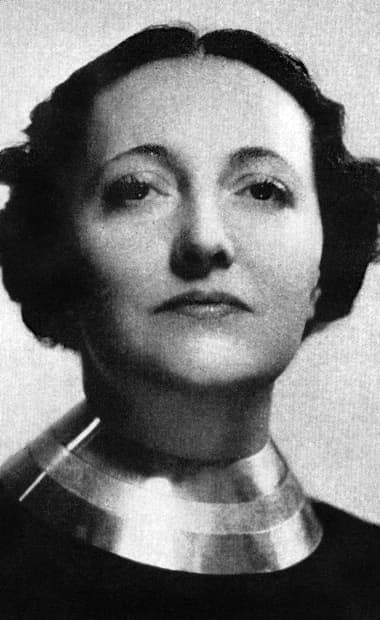
Germaine Monteil [1898-1985], a.k.a. Marie Germaine Moratille, and Germaine Bjorkman.
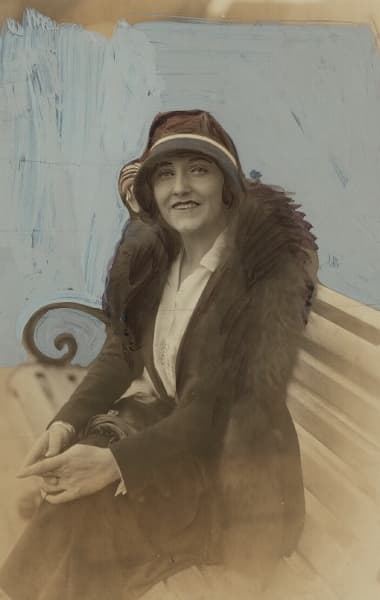
Germaine Monteil (Billy Rose Theatre Collection from the New York Public Library digital collection).

1938 “Beauty is not a gift its a habit”.
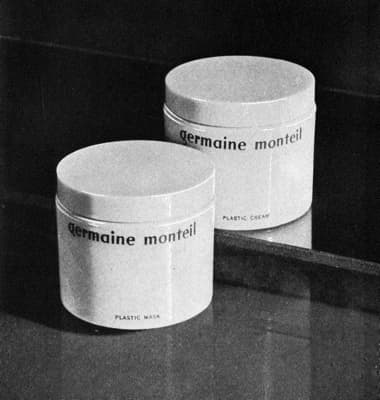
Plastic Cream and Plastic Mask.

Sunproof Lotion, Sun Cream (tube) and Suntan Oil.
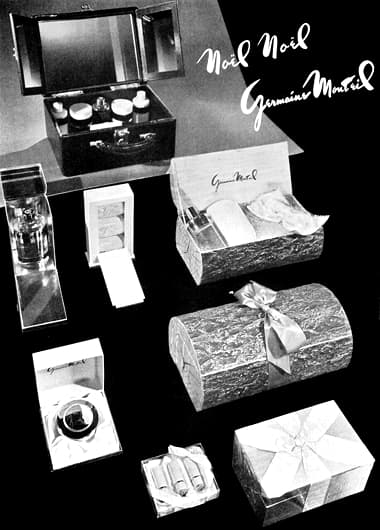
1939 Germaine Monteil Christmas gifts. Note the 24-carat gold plated compact (bottom left) and the lipstick wardrobe (bottom).
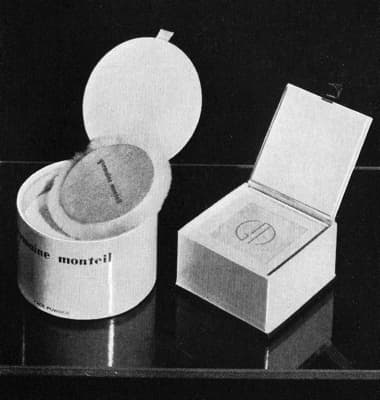
Germaine Monteil Face Powders.
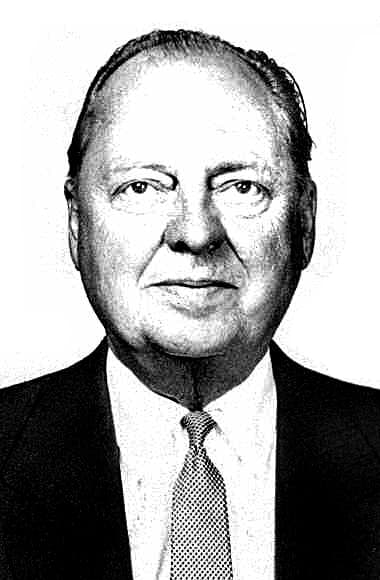
Guy Martin Bjorkman [1901-1999].

Germaine Monteil Lipstick and Rouge.

Germaine Monteil Eye Make-up.

1940 Germaine Monteil reviewing clothing designs.
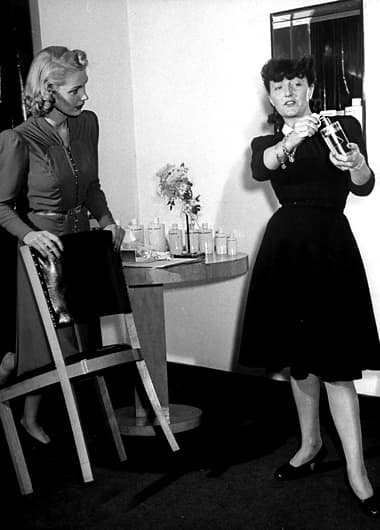
1940 Germaine Monteil explaining how to apply an Eau de Cologne by spraying it into the air and then walking into it (LIFE).
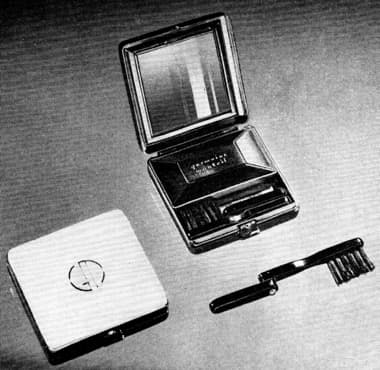
1940 A novel mascara case from Germaine Monteil.

1941 Germaine Monteil.

1941 Germaine Monteil Face Powder.
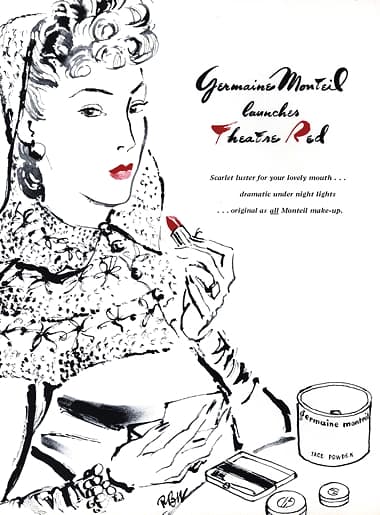
1941 Theatre Red.
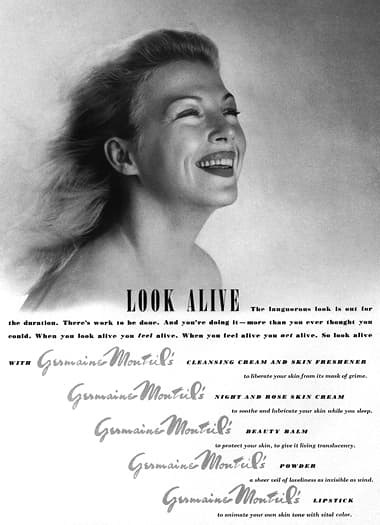
1942 Germaine Monteil.
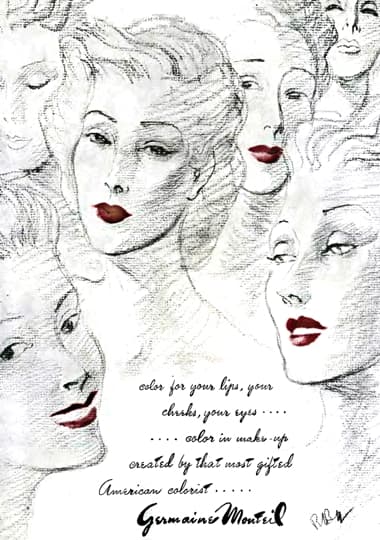
1942 Germaine Monteil – American colorist.

1943 Skin Cleanser and Skin Freshener.
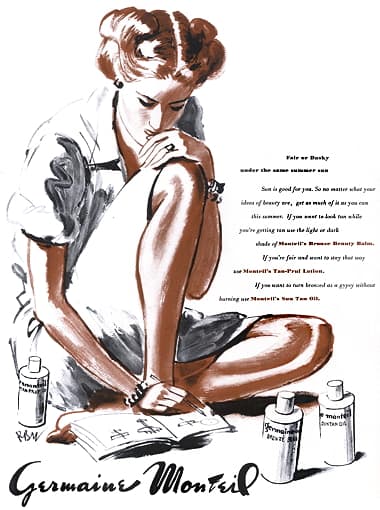
1944 Bronze Beauty Balm, Sun-Pruf Lotion and Sun Tan Oil.
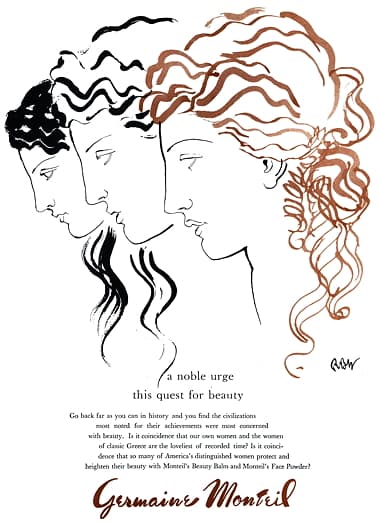
1944 Germaine Monteil.
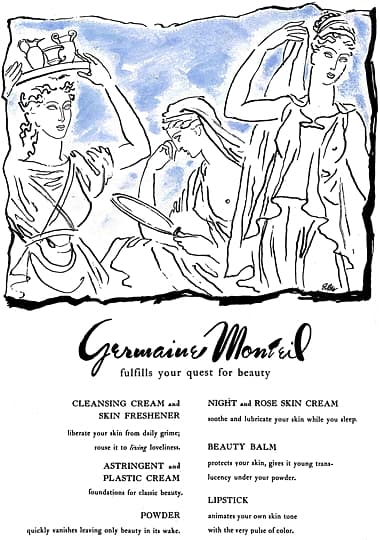
1944 Germaine Monteil.
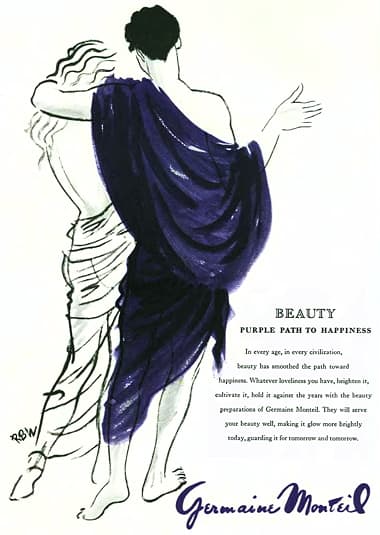
1944 Germaine Monteil.
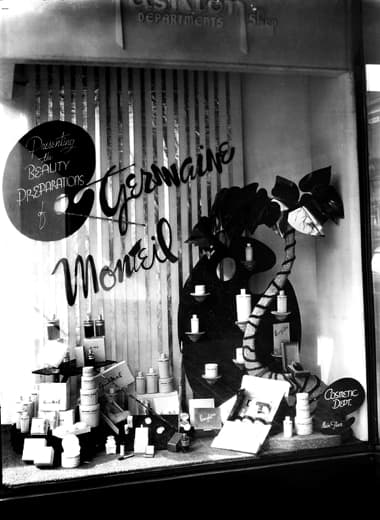
1945 Germaine Monteil window display.
